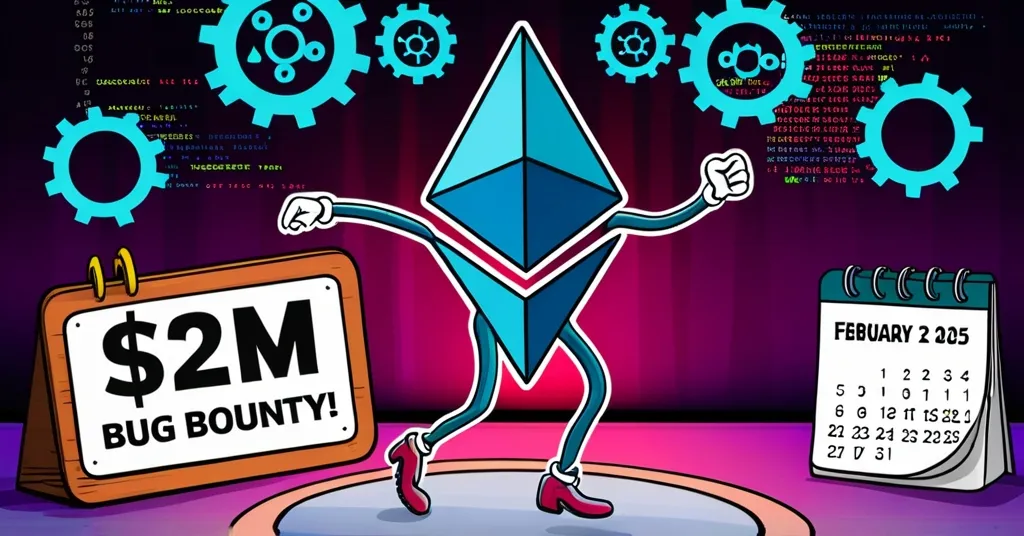Ethereum’s Pectra Upgrade: Devnet 6, EIP-7702, and $2M Bug Bounty Unveiled

Ethereum’s All Core Devs Meeting #150: Navigating the Pectra Upgrade
The 150th Ethereum All Core Devs Meeting on February 6, 2025, delved into the intricacies of the Pectra upgrade, aiming to propel Ethereum’s network to new heights of stability, scalability, and security. From the launch of Devnet 6 to the introduction of EIP-7702 and a robust $2 million bug bounty program, the meeting showcased Ethereum’s relentless pursuit of innovation while grappling with the realities of decentralized technology.
- Devnet 6 launched with improved stability
- EIP-7702 transaction handling discussed
- Testnet fork scheduled for February 13, 2025
- PeerDAS scaling and blob transactions explored
- New EIP for hardware and bandwidth requirements proposed
- Future fork planning to improve efficiency
- $2 million bug bounty program announced
The meeting opened with the launch of Devnet 6, Ethereum’s development network, which showed a marked improvement in stability and performance compared to Devnet 5. Devnet refers to Ethereum’s test environment used to test new features before they go live on the main network. This progress signals hope for Ethereum’s ongoing quest to refine its network, but it’s not without challenges. Concerns about Flashbots relay integration and execution requests in map-produced blocks serve as a reminder that in the world of blockchain, every step forward can reveal new hurdles. Yet, Ethereum’s devs are not just coding; they’re doing a high-stakes dance around complex issues, and we’re all invited to watch.
EIP-7702, aimed at enhancing transaction handling, took center stage. This Ethereum Improvement Proposal allows externally owned accounts (EOAs) to temporarily function as smart contract accounts during transactions, which could streamline how transactions are processed on Ethereum, leading to faster and more efficient transactions. However, the ambiguity surrounding transaction interactions and potential inconsistencies among clients sparked a lively debate. It’s a classic case of trying to innovate while keeping the ship afloat—exciting, but fraught with risks. Developers are wisely considering whether to roll this out now or refine it further, knowing that haste can lead to chaos.
The testnet fork, initially set for February 10, was rescheduled to February 13, 2025. This decision reflects Ethereum’s cautious approach to upgrades, prioritizing thorough testing over speed. It’s a relief to see the team focusing on stability rather than rushing to meet deadlines, even if it means waiting a bit longer for the next big update.
Scaling efforts with PeerDAS and the exploration of blob transactions were also discussed. PeerDAS is a scaling solution that aims to enhance Ethereum’s scalability by offloading proof computations to the Execution Layer. This could reduce bottlenecks and increase the number of blobs per block. It’s an ambitious move, but one that comes with its own set of challenges, including increased computational demands. The proposed Blob Parameter-Only (BPO) forks could revolutionize scalability if executed well, but as always, the proof is in the pudding—or the blobs, in this case.
A new EIP addressing hardware and bandwidth requirements sparked a debate on balancing network efficiency with decentralization. This proposal aims to standardize minimum hardware and bandwidth specifications to ensure nodes can handle upcoming network upgrades efficiently. It’s a delicate dance between pushing for better performance and ensuring the network remains accessible to solo stakers. The introduction of the Max Blobs Flag offers some control to node operators, but it’s a temporary fix to the broader issue of escalating hardware demands.
Reflecting on past hard forks, the developers emphasized the importance of better scope definition to streamline future upgrades. Planning Ethereum upgrades without clear scope is like trying to build a house without a blueprint—you might end up with a few surprises. A more structured approach could pave the way for smoother transitions, even if it means sacrificing some flexibility.
The meeting concluded with the announcement of a $2 million bug bounty program, dubbed the Attackathon, aimed at fortifying Pectra before its mainnet deployment. This initiative is part of a trend in the blockchain bug bounty programs to leverage crowdsourced security audits. The Attackathon not only aims to identify vulnerabilities but also fosters a sense of community and recognition among security researchers. It’s a bold move that underscores the community’s commitment to security, but also a sobering reminder that vulnerabilities may still lurk in the shadows. The Attackathon is a necessary step, and hopefully, it will help patch up any holes before they cause trouble.
Ethereum’s journey is a testament to the power of decentralization and the relentless pursuit of improvement. While the path is filled with hurdles, each meeting brings us closer to a more robust and scalable network. And if nothing else, at least we can all agree that Ethereum’s devs are keeping us on our toes—quite literally, given all the dancing around issues they’re doing.
Key Questions and Takeaways:
-
What improvements were noted in Devnet 6?
Devnet 6 showed improved stability and fewer issues compared to Devnet 5, with better response times and no significant failures during initial tests.
-
What are the main concerns with EIP-7702?
The primary concerns include ambiguity in transaction interactions, lack of clear specifications, and varying levels of client support, which could lead to inconsistencies.
-
Why was the testnet fork date changed?
The testnet fork was rescheduled to February 13, 2025, to allow more time for finalizing changes and ensuring stability.
-
How is Ethereum addressing PeerDAS scaling?
Ethereum is exploring offloading proof computations to the Execution Layer to reduce bottlenecks and increase the number of blobs per block.
-
What is the purpose of the new EIP for hardware requirements?
The EIP aims to standardize minimum hardware and bandwidth specifications to ensure nodes can handle upcoming network upgrades efficiently.
-
What lessons were learned from past Ethereum hard forks?
The need for better scope definition early in the development cycle was highlighted to prevent last-minute changes and improve upgrade efficiency.
-
What is the goal of the $2 million bug bounty program?
The Attackathon aims to identify and address vulnerabilities in the Pectra upgrade before its mainnet deployment, enhancing network security.



